
Cedar City is the largest city in Iron County, Utah, United States. It is located 250 miles (400 km) south of Salt Lake City, and 170 miles (270 km) north of Las Vegas on Interstate 15. It is the home of Southern Utah University, the Utah Shakespeare Festival, the Utah Summer Games, the Simon Fest Theatre Co., and other events. As of the 2010 census the city had a population of 28,857, up from 20,257 in 2000. As of 2019, the estimated population was 34,764.

Norseman is a town located in the Goldfields-Esperance region of Western Australia along the Coolgardie-Esperance Highway, 726 kilometres (451 mi) east of Perth and 278 metres (912 ft) above sea level. It is also the starting point of the Eyre Highway, and the last major town in Western Australia before the South Australian border 720 kilometres (447 mi) to the east. At the 2021 census, Norseman had a population of 562, of which 17% were Australian Aboriginal.
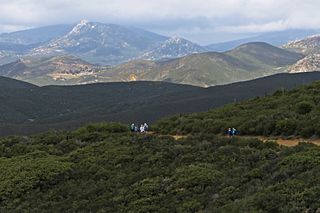
Cuyamaca is a region of eastern San Diego County. It lies east of the Capitan Grande Indian Reservation in the western Laguna Mountains, north of Descanso and south of Julian. Named for the 1845 Rancho Cuyamaca Mexican land grant, the region is now dominated by the 26,000-acre (110 km2) Cuyamaca Rancho State Park. Within the park is the prominent Cuyamaca Peak, the second-highest mountain in San Diego County at 6,512 feet (1,984.9 m).

Mount Magnet is a town in the Mid West region of Western Australia. It is one of the region's original gold mining towns, and the longest surviving gold mining settlement in the state. The prominent hill that is adjacent to the current townsite was called West Mount Magnet in 1854 by explorer Robert Austin, having named a smaller hill 64 km away, East Mount Magnet. Both hills had an extremely high iron content which affected the readings of his compass. West Mount Magnet had its Aboriginal name reinstated by the Surveyor General in 1972, "Warramboo," meaning campfire camping place. The magnetic variation at Mount Magnet is zero: magnetic north equals true north.

Burra is a pastoral centre and historic tourist town in the mid-north of South Australia. It lies east of the Clare Valley in the Bald Hills range, part of the northern Mount Lofty Ranges, and on Burra Creek. The town began as a single company mining township that, by 1851, was a set of townships collectively known as "The Burra". The Burra mines supplied 89% of South Australia's and 5% of the world's copper for 15 years, and the settlement has been credited with saving the economy of the struggling new colony of South Australia. The Burra Burra Copper Mine was established in 1848 mining the copper deposit discovered in 1845. Miners and townspeople migrated to Burra primarily from Cornwall, Wales, Scotland and Germany. The mine first closed in 1877, briefly opened again early in the 20th century and for a last time from 1970 to 1981.
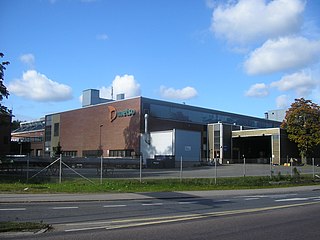
Metso Oyj was a Finnish industrial machinery company focusing on providing technology and services for mining, aggregates, and oil and gas, recycling, pulp and paper and other process industries.
Boliden AB is a Swedish multinational metals, mining, and smelting company headquartered in Stockholm. The company produces zinc, copper, lead, nickel, silver, and gold, with operations in Sweden, Finland, Norway, and Ireland.

Linden is the second largest city in Guyana after Georgetown, and capital of the Upper Demerara-Berbice region, located at 6°0′0″N58°18′0″W, altitude 48 m (160 ft). It was declared a town in 1970, and includes the communities of MacKenzie, Christianburg, and Wismar. It lies on the Demerara River and has a population of 27,277 as of 2012. It is primarily a bauxite mining town, containing many mines 60–90 m deep, with many other pits now in disuse. Linden is the regional capital of Upper Demerara-Berbice.
The Tintic War was a short series of skirmishes occurring in February 1856 in the Tintic and Cedar Valleys of Utah, occurring after the conclusion of the Walker War. It was named after a subchief of the Ute and involved several clashes between settlers and natives, mostly over the natives' theft of cattle because of drought.
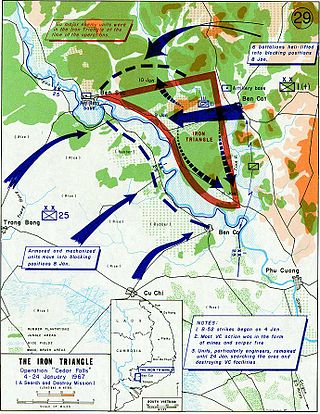
Operation Cedar Falls was a military operation of the Vietnam War conducted primarily by US forces that took place from 8 to 26 January 1967. The aim of the massive search-and-destroy operation was to eradicate the so-called "Iron Triangle", an area northwest Saigon that had become a major stronghold of the Viet Cong (VC).

Mercur is a historical hard rock mining ghost town in Tooele County, Utah, United States. In 1891, it became the site of the first successful use of the cyanide process of gold extraction in the United States, the dominant metallurgy today. Its elevation above sea level is approximately 2,042 m. The nearby Mercur Gold Mine was re-opened by Barrick Gold in 1985, with mining operations again coming to an end in 1997. The reclamation and restoration project was set to continue up to 2010.
Sydvaranger AS, previously A/S Sydvaranger, is an iron ore mining company in Sør-Varanger, Norway. Since 2015 its mining operations have not restarted yet. Sydvaranger is owned by Tacora resources, and it owns an open-pit mine at Bjørnevatn. Sydvaranger has traditionally hauled the ore with the Kirkenes–Bjørnevatn Line to Kirkenes for processing and shipping.

The Porcupine Gold Rush was a gold rush that took place in Northern Ontario starting in 1909 and developing fully by 1911. A combination of the hard rock of the Canadian Shield and the rapid capitalization of mining meant that smaller companies and single-man operations could not effectively mine the area, as opposed to earlier rushes where the gold could be extracted through placer mining techniques. Although a number of prospectors made their fortune, operations in the area are marked largely by the development of larger mining companies, and most people involved in the mining operations were their employees.
Cedar was a gold, silver and copper mining town in Mohave County, Arizona, United States. It was founded circa 1875 on the eastern slope of the Hualapai Mountains, sixty miles southeast of Kingman. A post office was established on September 24, 1895, and closed on July 31, 1911. In addition to the post office there were two saloons, and a general store with several homes. In 1907 the Cedar Valley Gold & Silver Company along with the Yucca Cyanide Mining & Milling Company reported that approximately 200 people lived in the town, within a decade later the site was abandoned. A half mile area inside Cedar Valley is littered with stone ruins and foundations of the mining buildings.
Since its incorporation in 1885, Missoula, Montana has been one of the primary media markets in the state of Montana, beginning with the weekly newspaper the Missoula and Cedar Creek Pioneer. The Missoula single-broadcast over-air television media market has been the largest in Montana since 2002. Though Billings is the largest city in Montana, Missoula's single-broadcast over-air television media market includes Missoula, Ravalli, Granite, Mineral, Lake, Flathead, and Sanders and serves over 113,000 television homes (2011). Missoula is also home to the state's third largest daily newspaper, the Missoulian, and the state's largest alternative weekly, the Missoula Independent.
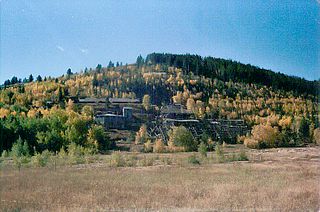
Trojan, also known as Portland, is a ghost town in the Black Hills of Lawrence County, South Dakota. It was established by and named after the Trojan Mining Company.
Galena is an unincorporated community in Lawrence County, South Dakota, United States. It is often considered to be a ghost town, even though a few families still live in the area. It is not tracked by the U.S. Census Bureau.
Prosperity is an unincorporated community in Jasper County, in the U.S. state of Missouri. It is northeast of Joplin and just southeast of Webb City, sitting east of Missouri State Highway 249.
Omco is an extinct town in Mineral County, in the U.S. state of Nevada. The GNIS classifies it as a populated place.
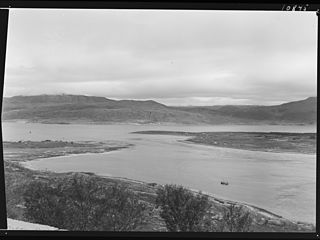
The Quenangen Mining Association was an English industry that operated copper mines in Kvænangen in the 1800s.














